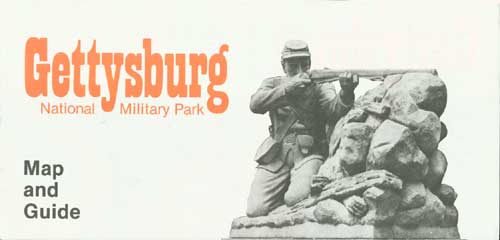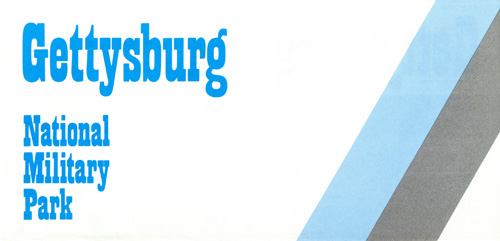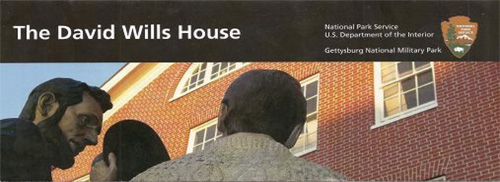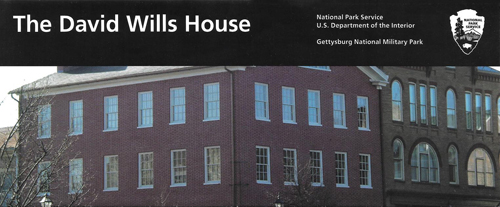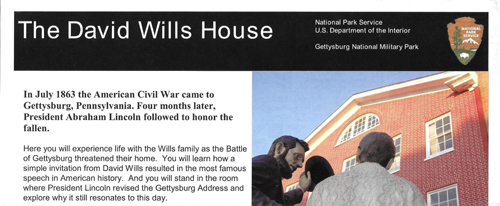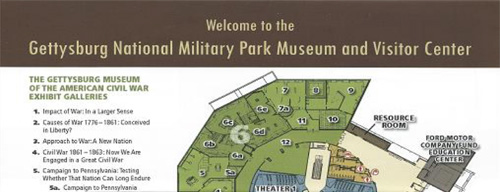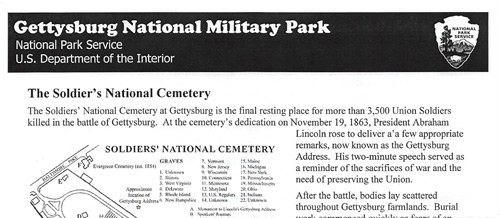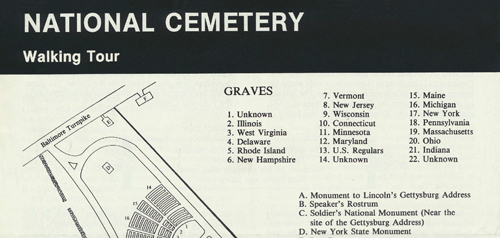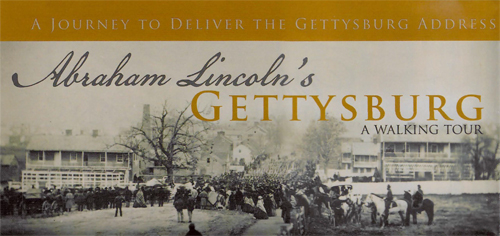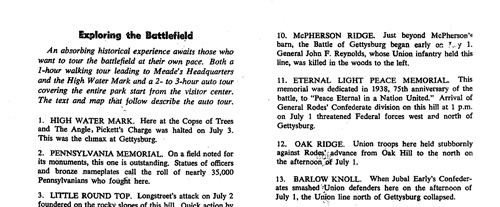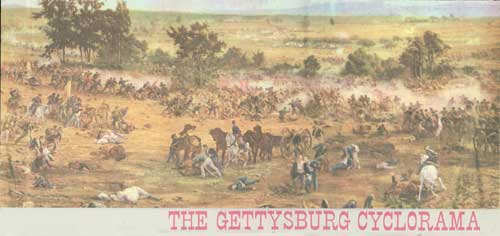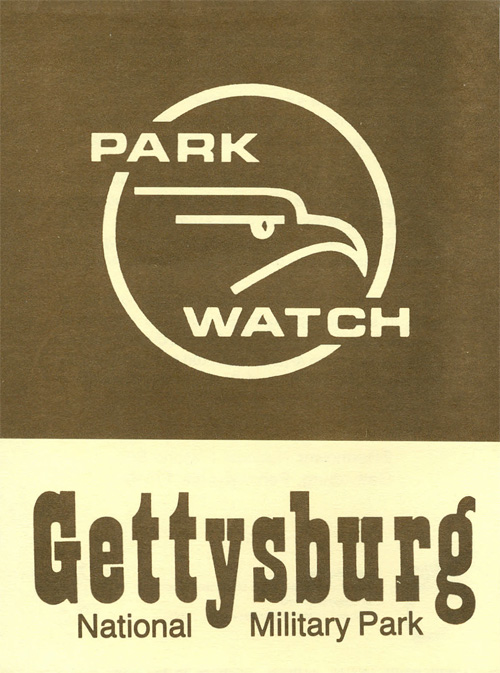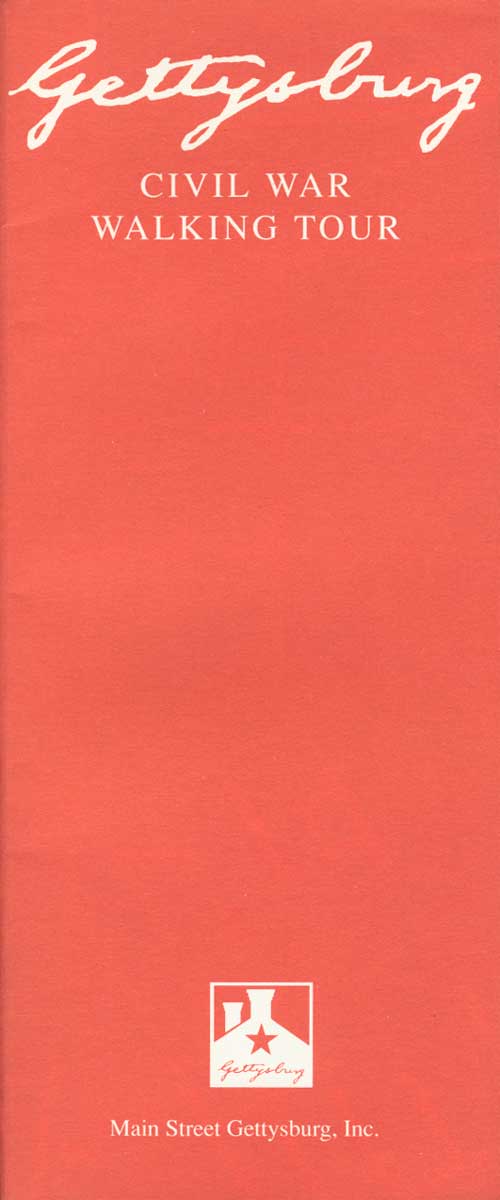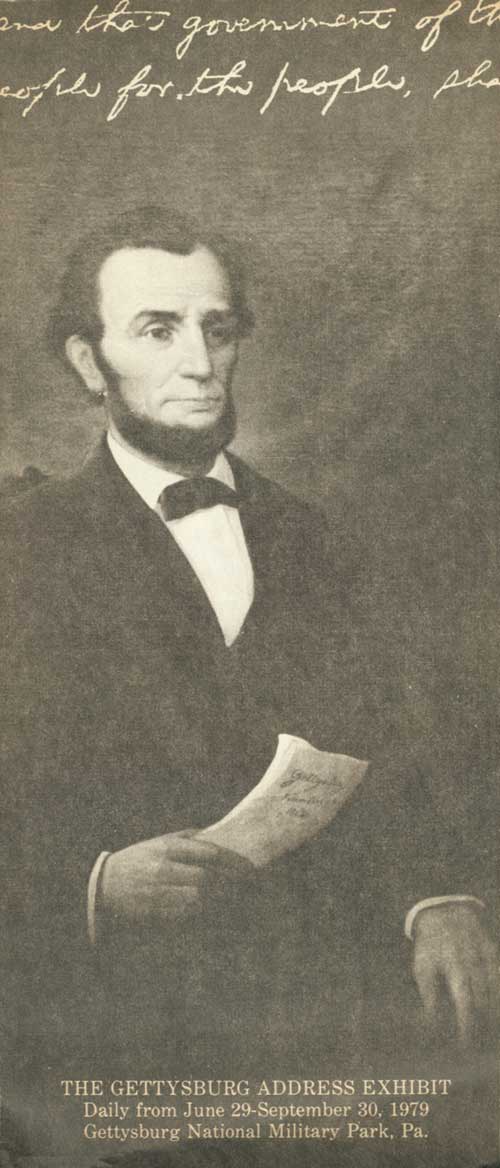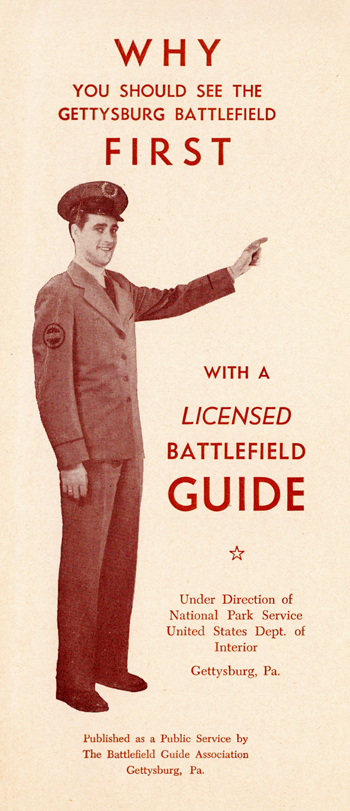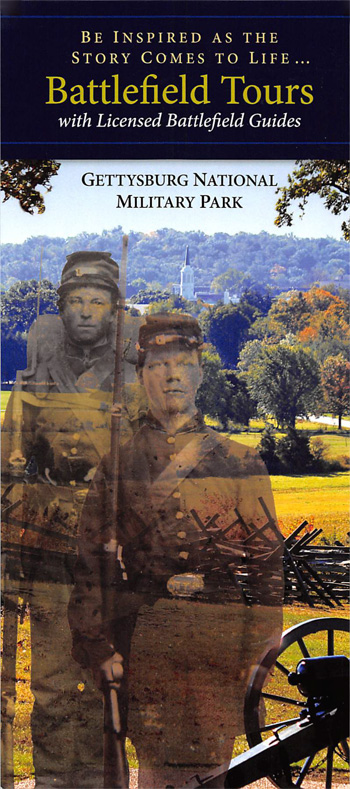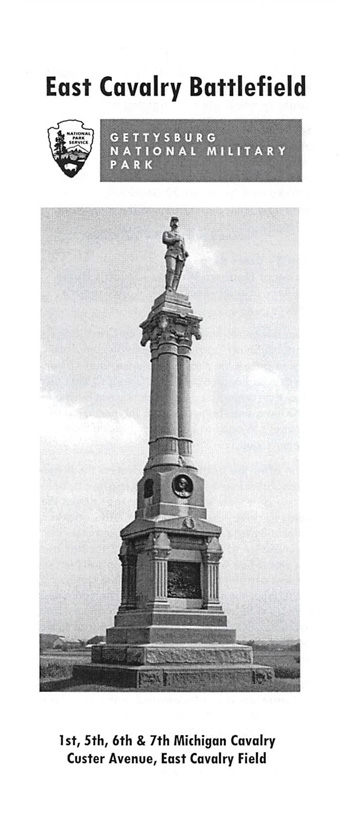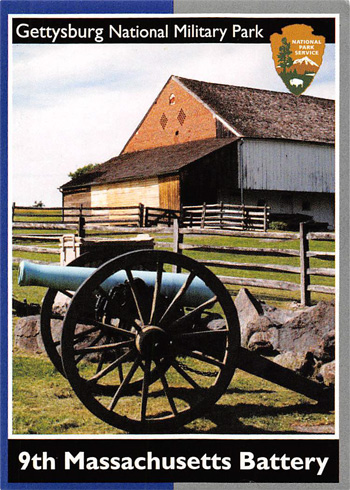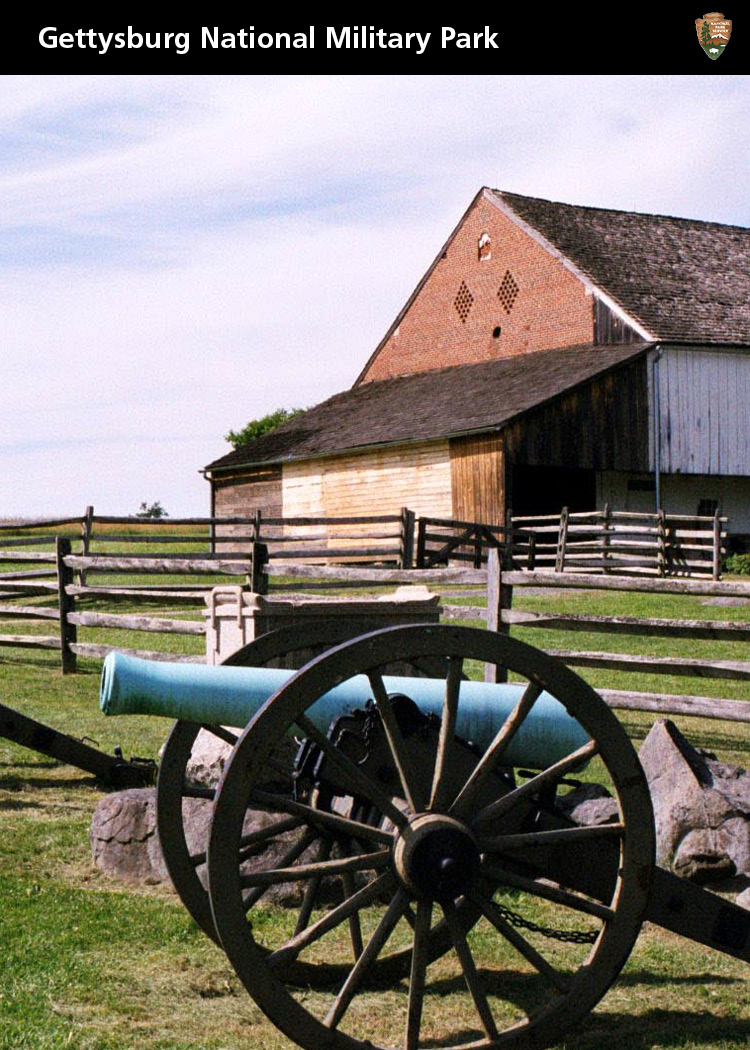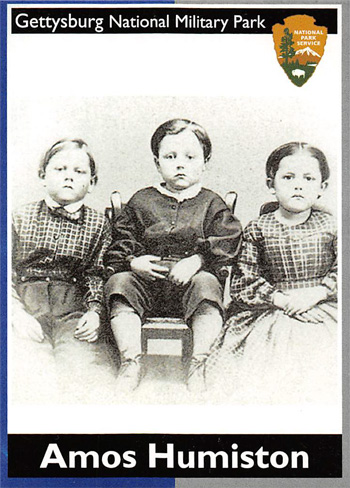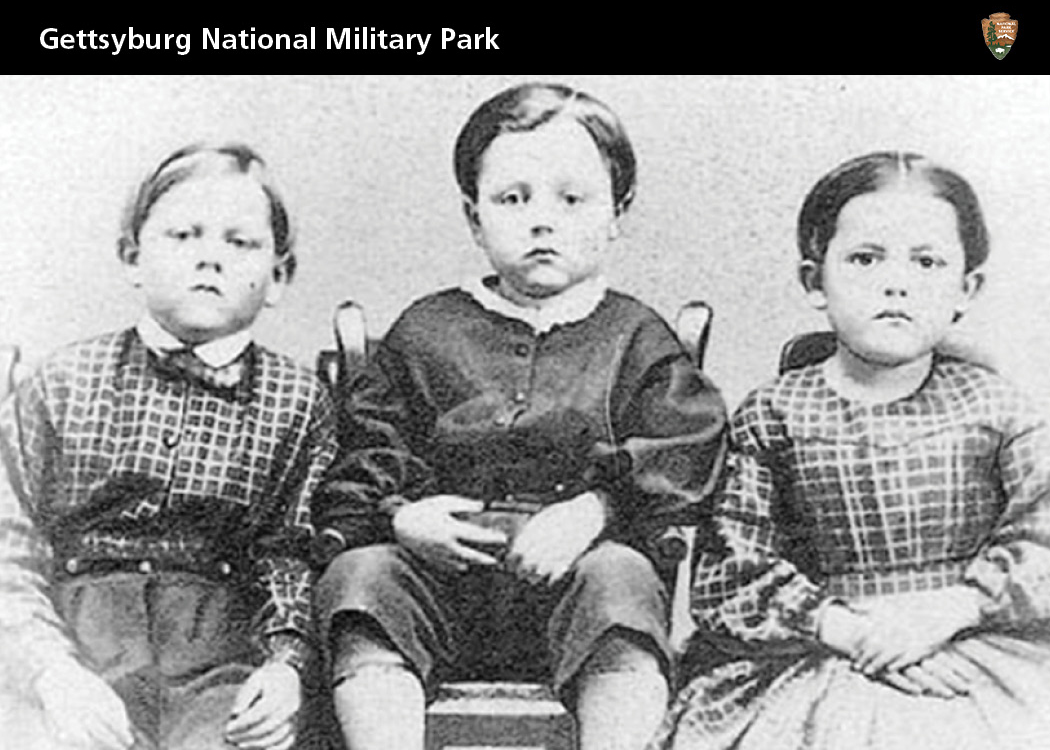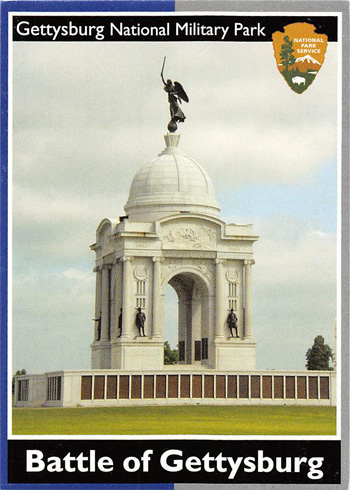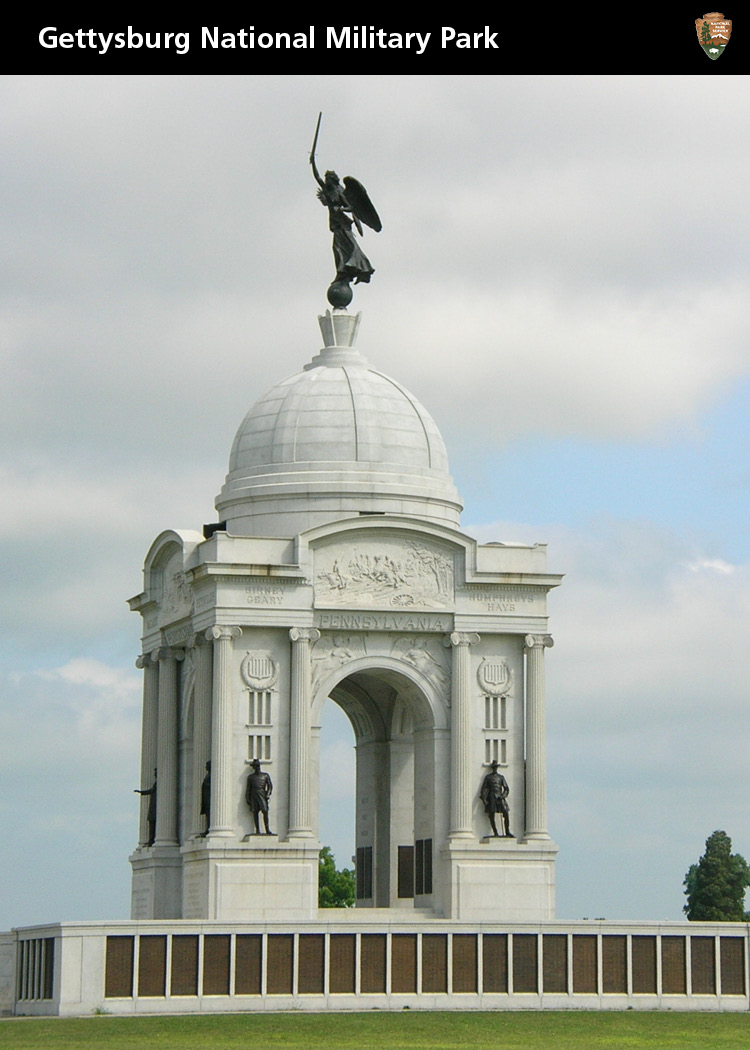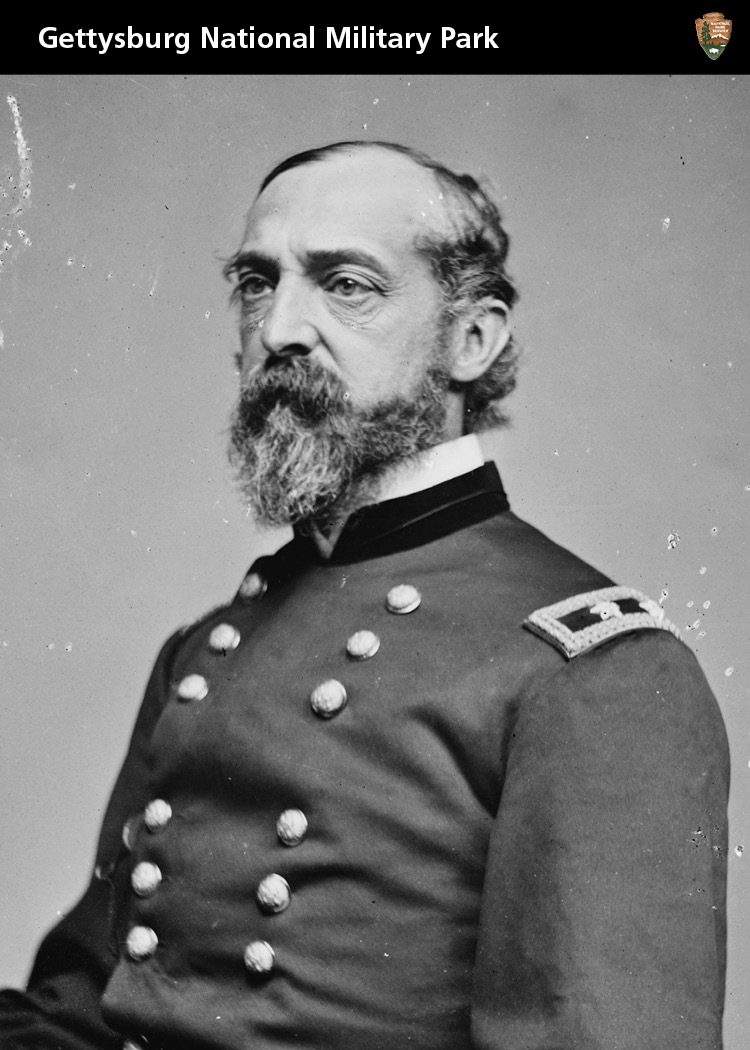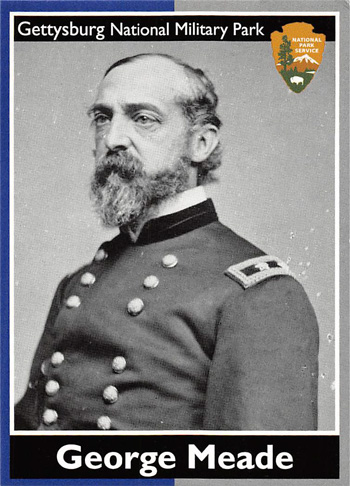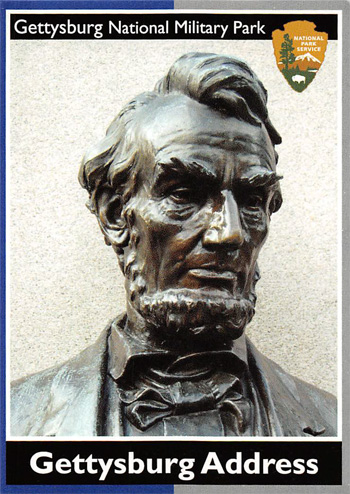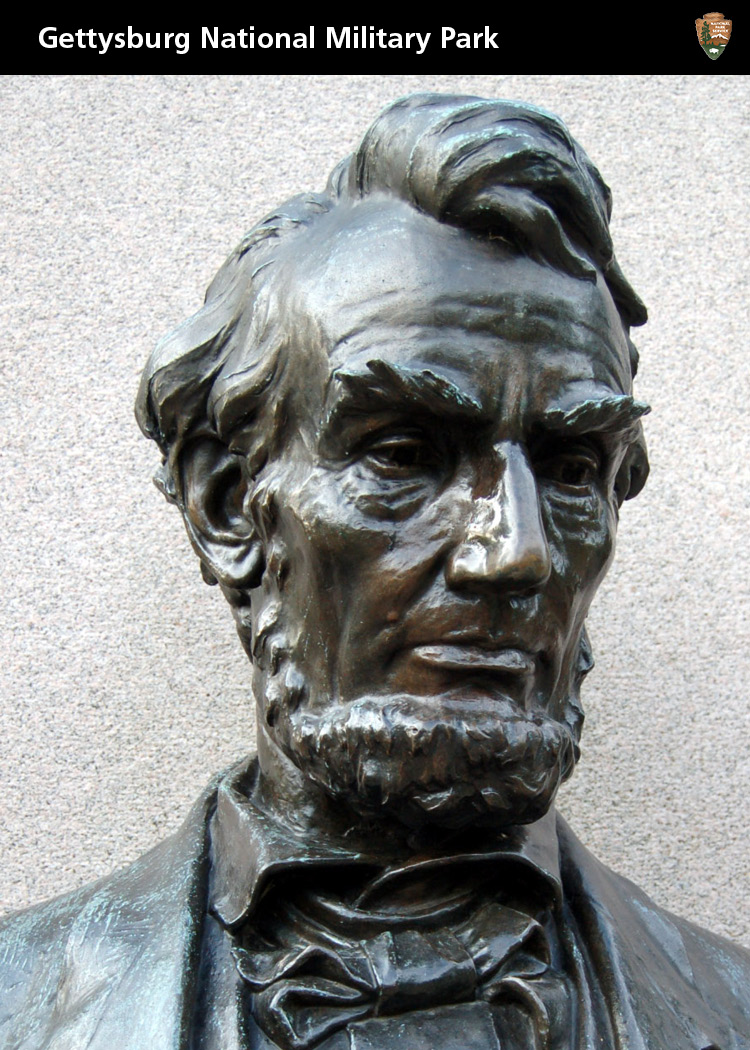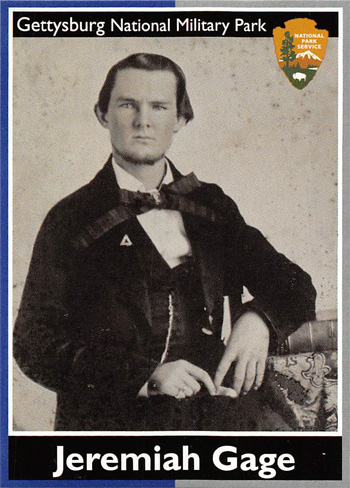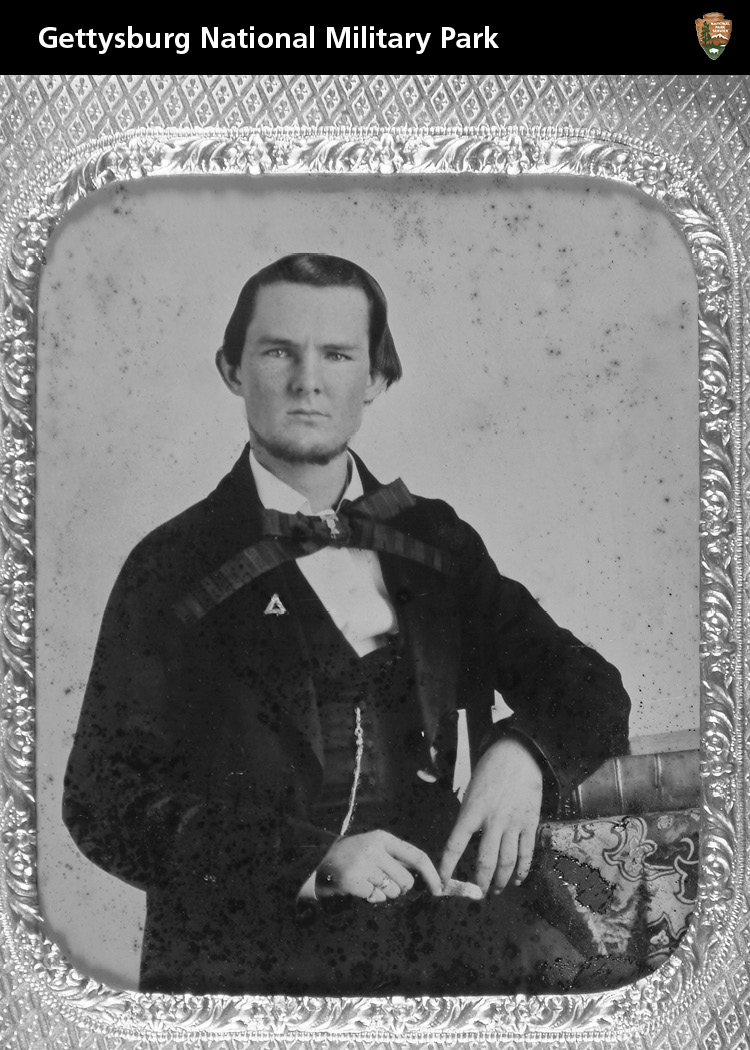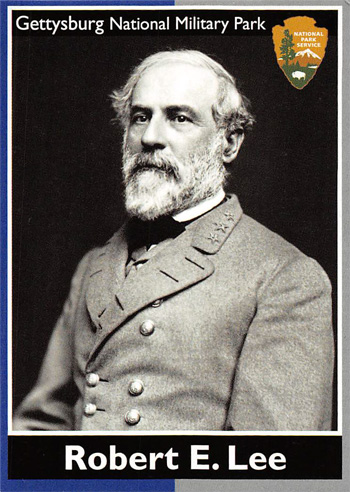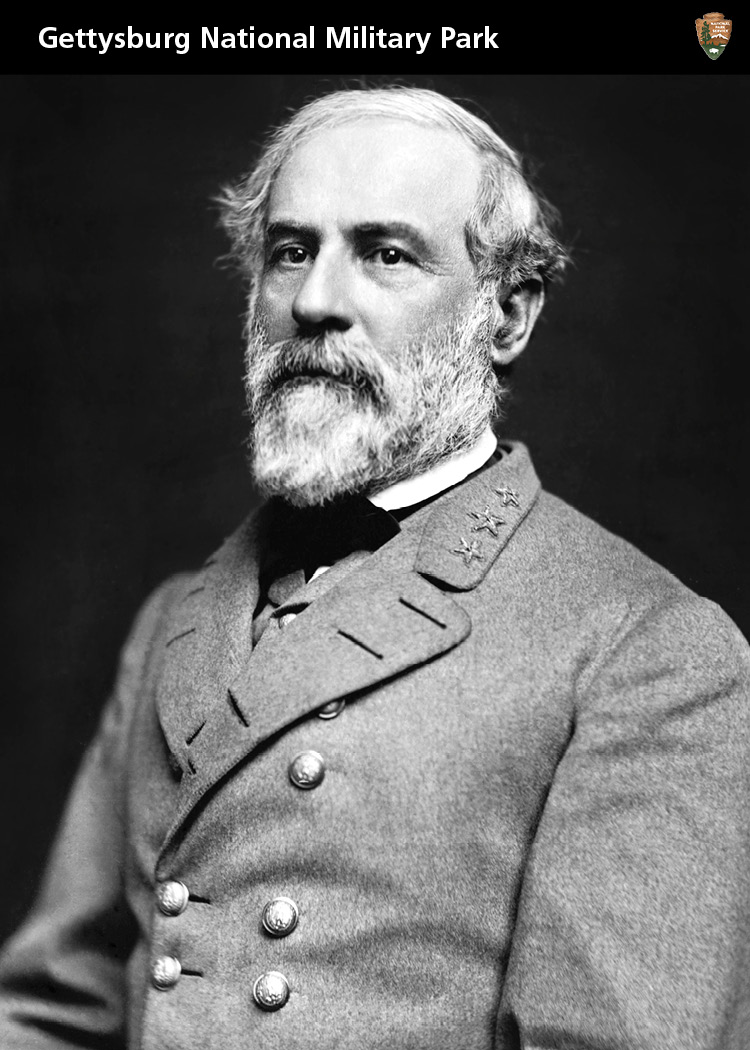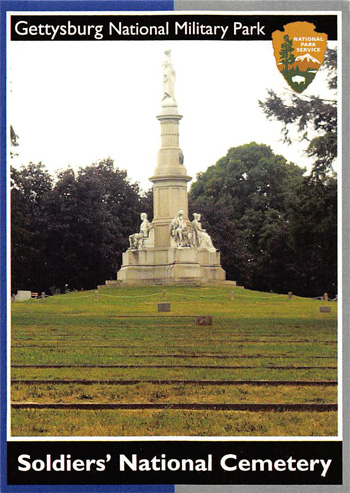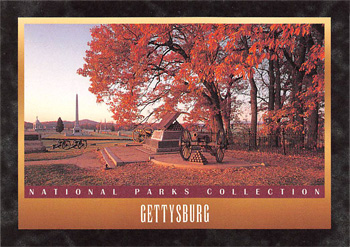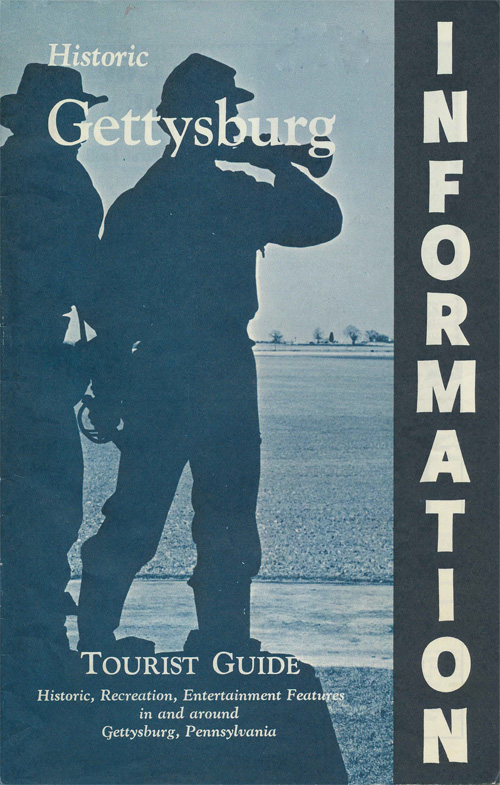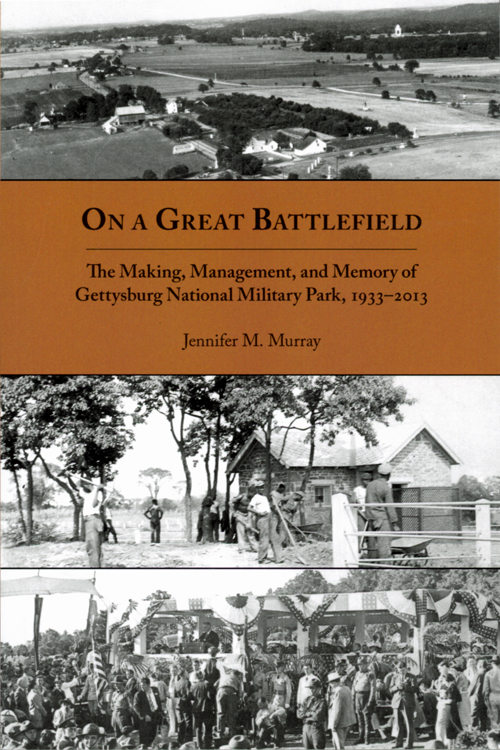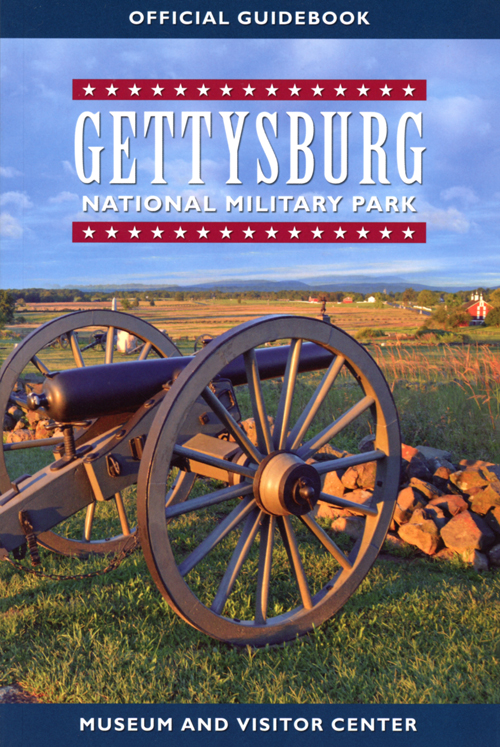|
Gettysburg National Military Park Pennsylvania |
 |
 NPS photo | |
Three Days in July
On June 3, 1863, a month after his dramatic victory at Chancellorsville, Confederate Gen. Robert E. Lee began marching his Army of Northern Virginia westward from its camps around Fredericksburg, VA. Once through the gaps of the Blue Ridge, the Southerners trudged northward into Maryland and Pennsylvania. They were followed by the Union Army of the Potomac under Maj. Gen. Joseph Hooker, but Lee, whose cavalry under Maj. Gen. J.E.B. Stuart was absent on a raid around the Federal forces, had no way of knowing his adversary's whereabouts.
The two armies touched by chance at Gettysburg on June 30. The main battle opened on July 1 with Confederates attacking Union troops on McPherson Ridge west of town. Though outnumbered, the Federal forces held their position until afternoon, when they were finally overpowered and driven back to Cemetery Hill south of town. During the night the main body of the Union army, now commanded by Maj. Gen. George G. Meade, arrived and took up positions.
On July 2 the battle lines were drawn up in two sweeping arcs. The main portions of both armies were nearly one mile apart on parallel ridges: Union forces on Cemetery Ridge, Confederate forces on Seminary Ridge to the west. Lee ordered an attack against both Union flanks. Lt. Gen. James Longstreet's thrust on the Federal left turned the base of Little Round Top into a shambles, left the Wheatfield strewn with dead and wounded, and overran the Peach Orchard. Farther north, Lt. Gen. Richard S. Ewell's evening attack on the Federal right at East Cemetery Hill and Culps Hill, though momentarily successful, could not be exploited to Confederate advantage.
On July 3 Lee's artillery opened a two-hour bombardment of the Federal lines on Cemetery Ridge and Cemetery Hill. This for a time engaged the massed guns of both sides in a thundering duel for supremacy, but did little to soften up the Union defensive position. Then some 12,000 Confederates advanced across open fields toward the Federal center in an attack known as "Pickett's Charge." The attack failed and cost Lee over 5,000 soldiers in one hour. The Battle of Gettysburg was over.
On November 19, President Abraham Lincoln traveled to Gettysburg to take part in the dedication ceremonies for the new Soldiers' National Cemetery. His brief speech, the Gettysburg Address, gave meaning to the sacrifices of the men who had struggled here, and stated that the war would lead to a "new birth of freedom" for the nation.
July 1
Elements of the two armies collide west of Gettysburg during the early
morning hours. The fighting escalates throughout the day as more Union
and Confederate troops reach the field. By 4 pm the defending Federal
troops are defeated and retreat through Gettysburg, where many are
captured. The remnants of the Union force rally on Cemetery and Culps
hills.
July 2
The main strength of both armies has arrived on the field by the morning
hours. General Lee launches attacks against the Union left and right in
an attempt to dislodge Meade's army from its strong position.
Longstreet's assault on the Union left makes good progress but is
eventually checked by Federal reinforcements from the center and right.
On the Union right, Ewell's Confederate troops are able to seize part of
Culps Hill; elsewhere they are repulsed.
July 3
While Ewell renews his efforts to seize Culps Hill, Lee turns his main
attention to the Union center. Following a two-hour artillery
bombardment, he sends some 12,000 Confederate infantry to try to break
the Federal lines on Cemetery Ridge. Despite a courageous effort, the
attack (subsequently called "Pickett's Charge") is repulsed with heavy
losses. East of Gettysburg, Lee's cavalry is also checked in a large
cavalry battle. Crippled by extremely heavy casualties, Lee can no
longer continue the battle. On July 4 he begins to withdraw for
Virginia.
The Gettysburg Address
When the armies marched away from Gettysburg they left behind a community in shambles and over 51,000 soldiers dead, wounded, or missing. Wounded and dying were crowded into nearly every building. Most of the dead lay in hastily dug and inadequate graves; some had not been buried at all.
This situation so distressed Pennsylvania Gov. Andrew Curtin, that he commissioned local attorney David Wills to buy land for a proper burial ground for Union dead. Within four months of the battle, reinterment began on 17 acres that became Soldiers' National Cemetery.
The cemetery was dedicated on November 19, 1863. The principal speaker, Edward Everett, delivered a well-received two-hour oration rich in historical detail and classical allusion. He was followed by President Abraham Lincoln, who had been asked to make "a few appropriate remarks."
Lincoln's speech contains 272 words and took about two minutes to deliver. It is considered a masterpiece of the English language, and it transformed Gettysburg from a scene of carnage into a symbol, giving meaning to the sacrifice of the dead and inspiration to the living. "I should be glad," Everett told Lincoln, "if I . . . came as near to the central idea of the occasion, in two hours, as you did in two minutes."
Contrary to popular belief, Lincoln did not write the speech on the back of an envelope during the trip to Gettysburg, but took great pains in its formulation. He composed the first draft in Washington and revised it at David Wills' house in Gettysburg, where the president stayed the night before the dedication.
The cemetery was far from completed by the day of the dedication. Within a few years over 3,500 Union soldiers who had been killed in the battle were reinterred here and the landscaping completed. Following the war the remains of 3,320 Confederate soldiers were removed from the battlefield to cemeteries in the South.
Both David Wills' House and the Gettysburg Train Station, at which Lincoln arrived on November 18, are located in historic downtown Gettysburg. The Wills' House has exhibits on Lincoln's visit to the town, the creation of the Soldiers' National Cemetery, and the Gettysburg Address. A shuttle bus system is available from the park visitor center to these sites and others in the downtown area.
The Soldiers' National Cemetery was designed by Washington, DC, architect William Saunders to reflect an appearance of what he called "simple grandeur." The New York Monument was dedicated in 1893 to honor New York state soldiers killed in the Battle of Gettysburg and buried in the national cemetery. Other United States veterans, from the 1898 War with Spain to the Vietnam conflict, are also buried here. Today the cemetery is the final resting place for over 6,000 honorably discharged veterans and their dependents.
Seeing the Park and the Battlefield
More men fell during the Battle of Gettysburg than in any other battle on American soil before or since. Today these peaceful rolling fields pay silent tribute to this sacrifice. Many Union soldiers who died here are buried in Soldiers' National Cemetery where Abraham Lincoln delivered the Gettysburg Address, honoring the men who gave the last full measure of devotion.
Much has been written and said about Gettysburg. But the most tangible connection to those three days in July is the battlefield itself, parts of which look much as they did in 1863. Fences, hills, rocks, cannon, and even the monuments provide an opportunity to reflect and try to understand what happened here.
Start at the Gettysburg National Military Park Museum and Visitor Center to visit the Gettysburg Museum of the Civil War, the fully restored Gettysburg Cyclorama, and the film, "A New Birth of Freedom" (admission required). The building also offers a book and museum store, food service, licensed battlefield guides, programs, and information about visiting Eisenhower National Historic Site.
To see the battlefield follow the Self-guiding Auto Tour. You can drive around the battlefield in two to three hours. At most of the numbered stops, exhibits and tablets describe significant action during the three days of battle.
The film "A New Birth of Freedom" and Gettysburg Cyclorama is a 45-minute ticketed experience designed as your starting point. The cyclorama is a sound and light show of the spectacular 377-foot painting by Paul Philippoteaux of Pickett's Charge, completed in 1884. For a fee, a licensed battlefield guide will conduct a two-hour tour of the battlefield in your auto or bus.
In summer, park rangers give presentations to explain the battle and its impact on the soldiers, civilians, and nation. The best way to get a feel for what happened here is to walk the battlefield and get a sense of the landscape.
Cemetery Ridge Trail (1.5-miles) begins at the visitor center and covers the ground defended by Union soldiers during Pickett's Charge.
National Cemetery Trail begins at the National Cemetery parking area and covers the cemetery grounds, where Union soldiers from the battle are interred and Abraham Lincoln delivered the Gettysburg Address.
For longer hikes, ask about the 9.5-mile Billy Yank Trail or the 3-mile Johnny Reb Trail. Both are part of the Boy Scouts of America's Heritage Trails Program.
We strive to make our facilities, services, and programs accessible to all.
Check with the Gettysburg Convention & Visitor Bureau at the visitor center for information on lodging, restaurants, campgrounds, museums, and other facilities. See: www.gettysburg.travel.
Regulations and Safety Tips
For your safety, backpacks and handbags are not allowed in the visitor center. Please leave them in the trunk or hidden in your vehicle. For firearms regulations check the park website.
Monuments and cannon mark positions and honor great sacrifices. They are irreplaceable historic objects. Please respect and help preserve them. Do not climb, stand, or hang on them.
All historic sites, structures, exhibits, plants, animals, and minerals must be left undisturbed. Relic collecting or the possession of a metal detector in the park is prohibited. Picnic in designated areas only.
Use extreme caution on park roads, especially at heavily traveled intersections. Obey speed limits. Be careful at blind curves and on one-way roads. Park in designated areas or on the pavement only, not on the grass or shoulders. Bicyclists keep to the right and ride with traffic.
Watch your children carefully, especially near roads and monuments.
Pets must be leashed and attended at all times. They are prohibited in the Soldiers' National Cemetery and visitor center. Service animals are welcome. If you have any questions about park rules or regulations, ask a ranger.
Touring the Battlefield
  (click for larger maps) |
Self-guiding Auto Tour
The 24-mile auto tour starts at the visitor center and includes 16 tour stops, the Barlow Knoll Loop, and the Historic Downtown Gettysburg Tour. It traces the three-day battle chronologically. You can include or skip certain points and stops based on your interest. Allow a minimum of three hours to complete the tour.
July 1, 1863
McPherson Ridge
The battle began about 8 am to the west beyond the McPherson barn. Union
cavalry confronted Confederate infantry advancing east along
Chambersburg Pike. Heavy fighting spread north and south along the ridge
as additional forces arrived.
Eternal Light Peace Memorial
At 1 pm Maj. Gen. Robert E. Rodes' Confederates attacked from this hill,
threatening Union forces on McPherson and Oak ridges. Seventy-five years
later, over 1,800 Civil War veterans helped dedicate this memorial to
"Peace Eternal in a Nation United."
Oak Ridge
Union soldiers here held stubbornly against Rodes' advance. By 3:30 pm
the entire Union line from here to McPherson Ridge had begun to crumble,
finally falling back to Cemetery Hill.
When the first day ended, the Confederates held the upper hand. Lee decided to continue the offensive, pitting his 70,000-man army against Meade's Union army of 93,000.
July 2, 1863
North Carolina Memorial
Early in the day, the Confederate army positioned itself on high ground
along Seminary Ridge, through town, and north of Cemetery and Culps
hills. Union forces occupied Culps and Cemetery hills, and along
Cemetery Ridge south to the Round Tops. The lines of both armies formed
two parallel "fishhooks."
Virginia Memorial
The large open field to the east is where the last Confederate assault,
known as "Pickett's Charge," occurred July 3.
Pitzer Woods
In the afternoon of July 2, Lt. Gen. James Longstreet placed his
Confederate troops along Warfield Ridge, anchoring the left of his line
in these woods.
Warfield Ridge
Longstreet's assaults began here at 4 pm. They were directed against
Union troops occupying Devils Den, the Wheatfield, and Peach Orchard,
and against Meade's undefended left flank at the Round Tops.
Little Round Top
Quick action by Brig. Gen. Gouverneur K. Warren, Meade's chief engineer,
alerted Union officers to the Confederate threat and brought Federal
reinforcements to defend this position.
The Wheatfield
Charge and countercharge left this field and the nearby woods strewn
with over 4,000 dead and wounded.
The Peach Orchard
The Union line extended from here to Devils Den and angled northward on
Emmitsburg Road. Federal cannon bombarded Confederate forces crossing
the Rose Farm toward the Wheatfield until about 6:30 pm, when
Confederate attacks overran this position.
Plum Run
While fighting raged to the south at the Wheatfield and Little Round
Top, retreating Union soldiers crossed this ground on their way from the
Peach Orchard to Cemetery Ridge.
Pennsylvania Memorial
Union artillery held the line here on Cemetery Ridge late in the day as
Meade called for infantry from Culps Hill and other areas to strengthen
and hold the center of the Union position.
Spanglers Spring
About 7 pm. Confederates attacked the right flank of the Union army and
occupied the lower slopes of Culps Hill. The next morning the
Confederates were driven off after seven hours of fighting.
East Cemetery Hill
At dusk, Union forces repelled a Confederate assault that reached the
crest of this hill.
By day's end, both flanks of the Union army had been attacked and both had held, despite losing ground. In a council of war, Meade, anticipating an assault on the center of his line, determined that his army would stay and fight.
July 3, 1863
High Water Mark
Late in the afternoon, after a two-hour cannonade, some 7,000 Union
soldiers posted around the Copse of Trees, The Angle, and the Brian
Farm, repulsed the bulk of the 12,000-man "Pickett's Charge" against the
Federal center. This was the climactic moment of the battle. On July 4,
Lee's army began retreating.
Total casualties (killed, wounded, captured, and missing) for the three days of fighting were 23,000 for the Union army and as many as 28,000 for the Confederate army.
National Cemetery
This was the setting for Lincoln's Gettysburg Address, delivered at the
cemetery's dedication on November 19, 1863. Use the Soldiers' National
Cemetery parking area on Taneytown Road.
Historic Downtown Gettysburg Tour
David Wills House
David Wills oversaw the creation of the Soldiers' National Cemetery.
Abraham Lincoln finished his Gettysburg Address here.
Gettysburg Train Station
The station served as a depot for supplies and evacuation of the wounded
after the battle. Abraham Lincoln arrived here on November 18.
Source: NPS Brochure (2017)
|
Establishment Gettysburg National Military Park — February 11, 1895 |
For More Information Please Visit The  OFFICIAL NPS WEBSITE |
Brochures ◆ Site Bulletins ◆ Trading Cards

Documents
"A Common Pride and Fame": The Attack and Repulse of Pickett's Division, July 3, 1863 — Part I (Kathleen R. Georg, January 1981)
"A Common Pride and Fame": The Attack and Repulse of Pickett's Division, July 3, 1863 — Part II (Kathleen R. Georg, January 1981)
"A Common Pride and Fame": The Attack and Repulse of Pickett's Division, July 3, 1863 — Part III (Kathleen R. Georg, January 1981)
Address Delivered at the Dedication of Monument of the 14th Conn. Vols. at Gettysburg, Gettysburg, Penn., July 3d, 1884 (Henry S. Stevens and J.W. Knowlton, 1884)
Administrative History: Gettysburg National Military Park and National Cemetery, Pennsylvania (Harlan D. Unrau, July 1991)
Activity Guide for Junior Ranger Candidates, Gettysburg National Military Park (Date Unknown; for reference purposes only)
Boundary Study, Gettysburg National Military Park: Draft Report to Congress / Environmental Assessment (August 1988)
Circumstances Surrounding the Dedication of the Soldiers' National Cemetery and of the Delivery by Abraham Lincoln of his Gettysburg Address, November 19, 1863 (Frederick Tilberg, September 27, 1957)
Cultural Landscape Report for First Day — Union 1st Corps Battlefield, Gettysburg National Military Park (Jon Auwaerter, Zhangshuai Wang, Anna Tiburzi and Nathaniel Bauder, 2021)
Cultural Landscape Report for Gettysburg National Cemetery, Gettysburg National Military Park (John Auwaerter, Catherine Ponte, Nathan Powers and Pamela Selby, 2017)
Cultural Landscape Report, Treatment & Management Plan: Little Round Top, Gettysburg National Military Park (Einhorn, Yaffee Prescott, Rhodeside & Harwell, Hunter Research, Fuss & O'Neill, Inc. and C.S. Davidson, Inc., March 2, 2012)
Cultural Landscapes Inventory: Gettysburg Landscape, Gettysburg National Military Park (2000, revised 2004)
Cultural Landscapes Inventory: Gettysburg National Cemetery, Gettysburg National Military Park (2019)
Cultural Landscapes Inventory: Little Round Top, Gettysburg National Military Park (2020)
Development Concept Plan: Guinn Woods Administrative Site Gettysburg National Military Park, Pennsylvania (August 1989)
Development Concept Plan: Environmental Assessment: Little Round Top/Devil's Den, Gettysburg National Military Park, Pennsylvania Draft (May 1985)
Development Policy for Gettysburg National Military Park (Farm Lands and Farm Structures) (November 14, 1938)
Economic Impacts of Gettysburg National Military Park/Eisenhower National Historic Site Visitor Spending on the Local Economy, 2000 (Daniel J. Stynes, Ya-Yen Sun and Dennis Propst, January 2002)
Edward McPherson Farm: Historical Study (Kathleen R. Georg, October 14, 1977)
Estimating White-tailed Deer Abundance at Gettysburg National Military Park and Eisenhower National Historic Site NPS Natural Resource Technical Report NPS/NER/NRTR-2012/626 (David P. Stainbrook and Duane R. Diefenbach, September 2012)
Final General Management Plan and Environmental Impact Statement: Gettysburg National Military Park (June 1999)
Final Report on the Battlefield of Gettysburg (New York Monuments Commission for the Battlefields of Gettysburg and Chattanooga, 1900)
Foundation Document, Gettysburg National Military Park, Pennsylvania (August 2016)
Foundation Document Overview, Gettysburg National Military Park, Pennsylvania (August 2016)
"Gallantry Unsurpassed": Proceedings of a Dedication Ceremony for a Monument to the 26th North Carolina Regiment, Gettysburg National Military Park 5 October 1985 (Archie K. Davis, ed., 1985)
Geohydrology and water quality in the vicinity of the Gettysburg National Military Park and Eisenhower National Historic Site, Pennsylvania USGS Water-Resources Investigations Report 89-4154 (A.E. Becher, 1989)
Geologic Resources Inventory Report, Gettysburg National Military Park & Eisenhower National Historic Site NPS Natural Resource Report NPS/NRPC/GRD/NRR-2008/083 (T.L. Thornberry-Ehrlich, March 2009)
Gettysburg and Lincoln: The Battle, the Cemetery, and the National Park (Henry Sweetser Burrage, 1906)
Gettysburg College - National Park Service Land Exchange: Study of Alternatives / Environmental Assessment Final Report (May 1995)
Gettysburg Design Guide: A Guide for Maintaining and Rehabilitating Buildings in the Gettysburg Historic District (Margaret M.M. Pickart, 1997)
1. The Changing Interpretations of Gettysburg. The First Annual Gettysburg Seminar. March 6-7, 1992. Gettysburg, PA: Gettysburg National Military Park (No papers published)
2. Battlefields as Sacred Ground. The Second Annual Gettysburg Seminar. March 5-6, 1993. Gettysburg, PA: Gettysburg National Military Park (No papers published)
3. The Public and Private Dwight D. Eisenhower. The Third Annual Gettysburg Seminar. March 5, 1994. Gettysburg, PA: Gettysburg National Military Park (No papers published)
4. Gettysburg 1895-1995: The Shaping of an American Shrine. The Fourth Annual Gettysburg Seminar. March 4, 1995. Gettysburg, PA: Gettysburg National Military Park (1995)
5. Unsung Heroes of Gettysburg. Programs of the Fifth Annual Gettysburg Seminar. March 23, 1996. Gettysburg, PA: Gettysburg National Military Park (1996)
6. Mr. Lincoln's Army: The Army of the Potomac in the Gettysburg Campaign. Programs of the Sixth Annual Gettysburg Seminar. 1997. Gettysburg, PA: Gettysburg National Military Park (1998)
7. The High Water Mark of an Army: The Army of Northern Virginia in the Gettysburg Campaign. Programs of the Seventh Annual Gettysburg Seminar. 1998. Gettysburg, PA: Gettysburg National Military Park (1999)
8. The American Civil War in 1863. Programs of the Eighth Annual Gettysburg National Military Park Seminar. 2000. Gettysburg, PA: Gettysburg National Military Park (2001)
9. "I ordered no man to go where I would not go myself": Leadership in the Campaign and Battle of Gettysburg. Papers of the Ninth Annual Gettysburg National Military Park Seminar. April 6-7, 2002. Gettysburg, PA: Gettysburg National Military Park (2002)
10. "This has been a terrible ordeal": The Gettysburg Campaign and First Day of Battle. Papers of the Tenth Gettysburg National Military Park Seminar. April 3-4, 2004. Gettysburg, PA: Gettysburg National Military Park (2005)
11. "The Most Shocking Battle I Have Ever Witnessed": The Second Day at Gettysburg. Papers of the 2006 (11th) Gettysburg National Military Park Seminar. April 8-9, 2006. Gettysburg, PA: Gettysburg National Military Park (2008)
12. The Fate Of A Nation: The Third Day at Gettysburg, July 3, 1863. Papers of the 2008 (12th) Gettysburg Seminar. April 12-13, 2008. Gettysburg, PA: Gettysburg National Military Park (2010)
13. Gettysburg: The End of the Campaign and Battle's Aftermath. Papers of the 2010 (13th) Gettysburg Seminar. April 10-11, 2010. Gettysburg, PA: Gettysburg National Military Park (2012)
14. Gettysburg In History and Memory. Papers of the 2012 (14th) Gettysburg Seminar. April 13-15, 2012. Gettysburg, PA: Gettysburg National Military Park (No papers published)
15. The Unfinished Work: Abraham Lincoln, David Wills and the Soldiers' National Cemetery. Papers of the Fifteenth Semi-Annual Gettysburg National Military Park Seminar, 2014. September 12-14, 2014 Gettysburg, PA: Gettysburg National Military Park (2015)
16. A Contrast in Commanders: Meade, Lee, and Their Commands at Gettysburg. Papers of the Semi-Annual Gettysburg National Military Park Seminar, 2017. May 12-14, 2017 Gettysburg, PA: Gettysburg National Military Park (May 2018)
Gettysburg National Military Park: Historic Handbook #9 (Frederick Tilberg, 1954, revised 1962)
Gettysburg National Military Park: Historic Handbook #9 (Frederick Tilberg, 1954, revised 1992, reprint 1988)
Historic Cemetery Survey Report: Gettysburg National Military Park (Frederick Tilberg, June 24, 1958)
Historic Structure Report: J. Slyder Farm Buildings (Part I), Gettysburg National Military Park (Frederick Tilberg, December 11, 1958)
Historic Structure Report: Physical Fabric Section, Leister Barn, Gettysburg National Military Park, Gettysburg, Pennsylvania (Reed L. Engle, 1986)
Historic Structure Report: The McClean Barn, Gettysburg National Military Park (Kenneth W. Holt and John M. Dickey, July 1985)
Historic views of Gettysburg: Illustrations in Half-tone of All the Monuments, Important Views and Historical Places on the Gettysburg Battlefield (Robert Miller, 1912)
Historical Base Map: Gettysburg National Park (Frederick Tilberg and Harry W. Pfanz, June 23, 1958)
Historical Importance of Rock Creek, Gettysburg National Military Park (Frederick Tilberg, September 1939)
Historical Statement: Henry Spangler Farm Buildings (Frederick Tilberg, August 31, 1956)
Inventory of Amphibian and Reptile Species at Gettysburg National Military Park and Eisenhower National Historic Site NPS Natural Resource Technical Report NPS/PHSO/NRTR-01/084 (Richard H. Yahner, Katharine L. Derge and Jennifer Mravintz, March 2001)
Inventorying and Monitoring Protocols of Terrestrial Vertebrates in National Parks of the Eastern United States: Gettysburg National Military Park and Eisenhower National Historic Site NPS Technical Report NPS/PHSO/NRTR-00/080 (Richard H. Yahner, Gerald L. Storm, Gregory S. Keller, Bradley D. Ross, and Ronald W. Rohrbaugh, Jr., December 1999)
Lee's Decision to Attack Cemetery Hill (Harry W. Pfanz, September 1957)
Longstreet's Delay at Gettysburg, July 2, 1863 (Harry W. Pfanz, September 1957)
McClean House and Barn, Gettysburg National Military Park, Pa. (Lenard E. Brown, October 1, 1968)
Monumental Guide to the Gettysburg Battlefield: with index, showing the location of every monument, marker and tablet, with approaching roads and avenues (Schuyler A. Hammond and Edgar M. Hewitt, 1899)
Natural Resource Condition Assessment, Gettysburg National Military Park and Eisenhower National Historic Site NPS Natural Resource Report NPS/NER/NRR-2017/1369 (Mary-Jane James, January 201)
Newsletter (The Gettysburg Quarterly): Vol. 13 No. 2, Fall 2006 • Vol. 14 No. 2, Fall 2007 • Vol. 15 No. 1, Fall 2008 • Vol. 16 No. 2, Fall 2009 • Vol. 17 No. 1, Winter/Spring 2010 • Vol. 17 No. 2, Summer 2010 • Vol. 17 No. 3, Fall 2010 • Vol. 18 No. 1, Winter 2010/2011 • Vol. 18 No. 2, Spring 2011 • Vol. 18 No. 3, Fall 2011 • Vol. 17(18?) No. 4, Winter 2011/2012 • Vol. 19 No. 3, Fall 2012 • Vol. 19 No. 4, Winter 2012/2013
"Our Principal Loss Was in This Place": Action at the Slaughter Pen and at the South End of Houck's Ridge, July 2, 1863 (Kathleen R. Georg, March 18, 1984)
Proposed Restoration of the Spangler's Spring-Culp's Hill Area and the Re-Location of Avenues in the Area of the Spring (Frederick Tilberg, July 20, 1940)
Regulations for the Government of the Gettysburg National Military Park, Gettysburg Penna. (1911)
Regulations for the National Military Parks And the Statutes under which they were Organized and are Administered (rev. ed. 1915)
Report on McMillan House: Architectural section, Gettysburg National Military Park (Norman M. Souder, January 1962)
Report on Proposed Extension of Gettysburg Borough Line Southward Along Emmitsburg Road and a Historical Statement Relating to the Significance of This Area (Frederick Tilberg, September 6, 1940)
Report on the Operation of Park Entrance Stations, Gettysburg National Military Park (Frederick Tilberg, January 1938)
Report on the Proposed Restoration of the Bryan House (Frederick Tilberg, November 20, 1943)
Strategy Proposed by Longstreet for the Gettysburg Campaign (Harry W. Pfanz, September 1957)
The Brien Farm and Family (Marcella Sherfy, June 1972)
The Development and Care of the Soldiers' National Cemetery Enclosures at Gettysburg (Kathleen R. Georg, June 16, 1978)
The Ecology of Big Round Top (William C. Darrah, 1995)
The Gettysburg Address Exhibit (1984)
The Gettysburg Address: Issues Related to Display and Preservation GAO/RCED-94-12 (January 1994)
The Harry Pfanz Research Collection
The High Water Mark: Proceedings of a Dedication Ceremony for a Monument to the 26th North Carolina Regiment, Gettysburg National Military Park, 4 October 1986 (Archie K. Davis, ed., 1986)
The Location of the Monuments, Markers and Tablets on the Battlefield of Gettysburg (1907)
The Location of the Monuments Markers, and Tablets on Gettysburg Battlefield (Kathy Georg Harrison, comp., 1993)
The Locations of the Monuments, Markers and Tablets on the Battlefield of Gettysburg (1932)
The Road Inventory of Gettysburg National Military Park (Federal Highway Administration, October 1998)
The Significance of the Harmon Farm and the Springs Hotel Woods (Kathleen Georg Harrison, March 1, 1991)
Treatment Philosophy: The 1863 Landscape (Gettysburg) (Eric Campbell, March 2004)
Vista Cutting Project: Area of Little Round Top, Devil's Den, the Wheatfield, and Peach Orchard (Frederick Tilberg, December 28, 1939)
Gettysburg (NPS)
Books

gett/index.htm
Last Updated: 21-Nov-2023

















